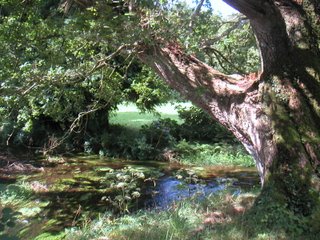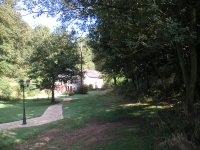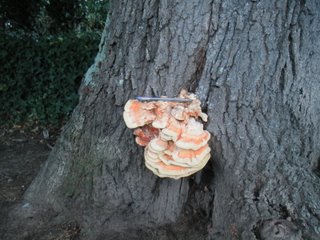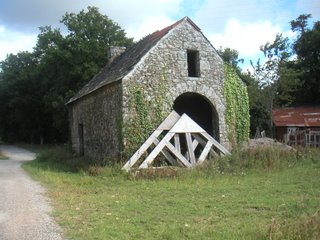Walk 4: A walk on the wet side. Transcorff
TranscorffWell dear walker, this was one of those walks when you cannot avoid it - getting wet. Inside and out. It was a persistent drizzle, and the heat of wearing a waterproof makes you drip inside as much as out....however, this is more than compensated by the life saving properties of hot chocolate on one's return.
Even on a fine day though this one has streams, rivers and mud....check that footware! This walk takes in some wet, uneven ground, goes over some fields and crosses the Scorff at two of it's more productive points.
To start, head out down
rue des Trois Freres to
Meubles de Poher, and carry on to the major junction marked for
Rostrenen, beside the
KnapfPack Ouest factory on your left. (and no, I don't know what they do there....)
About 500 m up there is a right hand turn for
Langoelan, take this road and you are walking into the
Vallee du Scorff. Note the steeply rising rocky outcrops on the left - left when the softer glacial till was washed away millenia ago. Less than 1/2 km on you will come to a lay-by on the right that is signed for the Scorff circuit. Here, walk down through the trees and cross the footbridge.
 Moulin A Tan - the Tanning Mill
Moulin A Tan - the Tanning MillYou can wade across the ford if you wish - we do in summer and it is most pleasant. Here you will find yourself on a wide sweeping lawn, with a five headed lamp reminiscent of the Lantern Waste in Narnia. I was confused when I came here first, but heading left is the proper way to go as this is a randonnee path, and soon a fence seperates you from the garden. This is the Moulin A Tan - it was an old water-driven tanning mill in the days when Guémené was an important market for fabrics. Continue along this path and you will see the Moulin de Nicholas on the far bank. There is a definite race to the water here and this stretch is deep and rushy.
Walking along the edge of the forest, you will see little wooden signs in breton and french - 'sapin' is pine, 'orme' is elm, 'noisetier' is hazel and 'chene' is oak. Others are 'bouleau' - birch, 'hetre' - beech , 'marronier' - sweet chestnut and 'cerisier' - cherry. And some are named intriguingly - 'What am I?' 'Que suis je?'
Going deeper along the woodland path, it takes you through across some little rivulets, so watch your step. This walk is mushy and wet, but wonderful for the imagination. Look at the tumbledown wall and stream on the right - it seems to be a fairy grotto, the half rotted logs take on all sorts of shapes when glanced at quickly and here there are deer that come down off the hills occasionally.....
Aftere a while there is a definite fork in the path - not a turning, and keeping straight on you cross in quick succession three small bridges. The first is large stone slabs, where the Scorff used to be. The next two wooden ones - take care as there is only one handrail on the second - are where the tributary now joins the main river. This is a haven for water boatmen, pond skaters and damsel-flies in summer. Now only a single, blue jay feather floats on a little eddy. Striking on the path takes a decidely muddy turn upwards - initially a bit steep after the forest floor.
 Walking through head-high bracken
Walking through head-high brackenYou emerge into the edge of a field where the bracken - depending on your height - can brush the top of your head. My saturation becomes complete as my legs are slicked and christened by the waving fronds that border the field and forest. This particular day, the field is scattered with old barley haulms, other years it is yellowing corn, or purpling, curled phacelia. The path continues along the headland and comes out on hard-top road. The road curls to the left and down to the valley bottom. Back to the Scorff.

As you walk down this road, watch out for the
Smallest House In Brittany, as my trio call it - it really has the appearance of a dolls house - I have wondered at the scale of the furniture that must be in it. Opposite a farmyard, I can only guess it is an extremely well made out house, now converted, or the house of a widowed dowager who was no longer allowed live in the main home.
On our way down we come back to the Scorff and it's main occupation - Mills! There is a tiny mill with a race on the side of the house to the left. And the old Laverie can be found if you look carefully through the trees on the right. It has the appearance of a green temple and the water from the spring in front is quite refereshing.
 Old Laverie, Transcorff
Old Laverie, TranscorffCross the bridge and there is a most impressive and well built mill right on
Transcorff itself. This has outbuildings; a huge mill-house; crashing, white-water race (no wheel!) and a beautiful view of the pool beneath. This is the floor of the valley, so walk on up the road to the main road and layby that lies straight ahead. When you are a the layby, look straight across the road - you will see a small gap that leads into the forest on the opposite side. Crossing over, dive into the forest and stike on up until the path hits a larger track. Turn left on this track. This takes you along stands of Western cedar, birch and then open groves of sweet chestnut. The going here is easy and springy, but roots have a habit of popping up. The track ends in a T-junction faced by a field. Take the right hand turn and follow the wall round on your left. You are now in the woods of
Crenenan. Stick to the lower track and you will see the valley spreading out on the left, where houses and the roads fade into the forest. This is frequented by other walkers, quad bikes and horses - so you may have company!
The springy woodland track curves and sweeps for about 2 km before Guémené hoves into view below you. Just keep the wall and the valley to your left and you will come to a soft grassy track that opens up between two or three houses,
Les Mimosas. You are now above those rocky cliffs that we saw earlier. Walk down and it becomes hard top again and a the bottom of the lane, there is KnapfPack Ouest on the other side of the road, leading to Guémené.
Time for a hot chocolate at La Girelle, methinks.....
2 hours - depending on how long you stand gazing into pools and swirling eddies.















